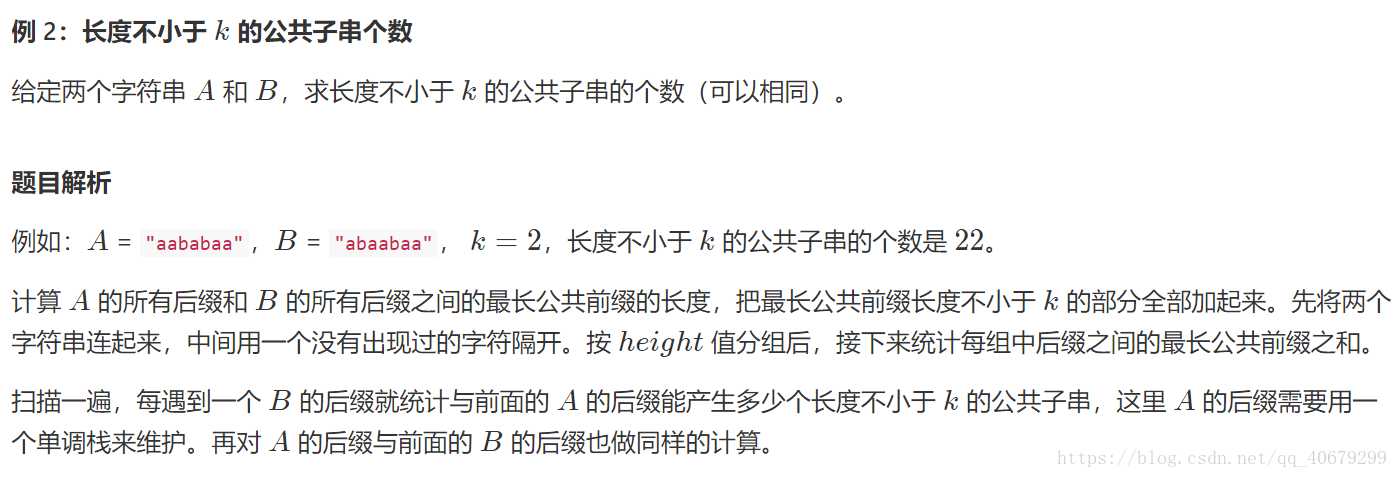标签:using 匹配 计算方法 algorithm mamicode 方便 sdn gray cst

首先,height[i]-k+1 很好理解把,他是说明目前这对后缀中不小于k的公共子串个数。
题解说用单调栈维护,为什么要用单调栈维护呢?因为时间复杂的可以大大降低。
怎么个降低方法呢?
在之前学习lcp(就是height数组)的时候,肯定接触过这样一个问题,就是从i开始的后缀字符串跟从j开始的后缀字符串的最长公共前缀。
计算方法是:取height[rank[i]+1]~height[rank[j]]的最小值
利用上面这个性质来维护单调递增的栈。
借助我看的那篇博客上面说的:
为什么要这样呢?可以理解为栈里是可能被用到的候选序列,如果当前扫描到的height小于栈顶(候选最大值),则根据上面的性质,
可以得出大于height的值是无法做出贡献了,那累加器的值要更新
把每一个height的值捆绑一个num,原因是再进行更新的时候,直接减去栈顶对应的num*(栈顶对应的height-当前的height)。
单调栈维护到height[3]的时候,比栈顶小了,所以说height[2]的最后一个a贡献不了了。所以直接减去就行了。但不要忘了维护num,现在还不懂维护这个干嘛,接着往下看。
现在到了height[4]了,又比栈顶小,又得减去栈顶最后多贡献的a,现在num(num此时为2)就真正派上用场了,因为之前维护了两个子序列。减去num*(栈顶对应的height-当前的height),就直接将多贡献的剪掉了。
上面是B串中的子串不断匹配rank比其高的A子串
再做一次A串中的子串不断匹配rank比其高的B子串
合并的答案就是最终的答案。
什么?这会有重复的吗?答案是不会。
因为对于B组后缀j,我统计答案都是在sa[j]之前找。
比如说找到A组中的ii,jj,kk三个后缀是符合的,那必定有sa[ii]、sa[jj]、sa[kk]都小于sa[j]
所以在统计A组时,sa[ii]也是在sa[ii]之前找,不可能找到sa[j]
————————————————
版权声明:本文为CSDN博主「Combatting」的原创文章,遵循 CC 4.0 BY-SA 版权协议,转载请附上原文出处链接及本声明。
原文链接:https://blog.csdn.net/qq_40679299/article/details/82285379
1 #include<cstdio> 2 #include<algorithm> 3 #include<math.h> 4 #include<map> 5 #include<string.h> 6 #define eps 1e-9 7 #define LL long long 8 #define PI acos(-1.0) 9 #define bitnum(a) __builtin_popcount(a) 10 using namespace std; 11 typedef long long ll; 12 const int N = 2e5+10; 13 const int M = 2e5+10; 14 const int inf = 1000000007; 15 const int mod = 1000000007; 16 const int MAXN = 2e5+10; 17 //rnk从0开始 18 //sa从1开始,因为最后一个字符(最小的)排在第0位 19 //height从1开始,因为表示的是sa[i - 1]和sa[i] 20 //倍增算法 O(nlogn) 21 22 int wa[MAXN], wb[MAXN], wv[MAXN], ws_[MAXN];//求后缀的数组参数 23 24 //Suffix函数的参数m代表字符串中字符的取值范围,是基数排序的一个参数,如果原序列都是字母可以直接取128,如果原序列本身都是整数的话,则m可以取比最大的整数大1的值 25 //待排序的字符串放在r数组中,从r[0]到r[n-1],长度为n 26 //为了方便比较大小,可以在字符串后面添加一个字符,这个字符没有在前面的字符中出现过,而且比前面的字符都要小 27 //同上,为了函数操作的方便,约定除r[n-1]外所有的r[i]都大于0,r[n-1]=0 28 //函数结束后,结果放在sa数组中,从sa[0]到sa[n-1] 29 void Suffix(int *r, int *sa, int n, int m) 30 { 31 int i, j, k, *x = wa, *y = wb, *t; 32 //对长度为1的字符串排序 33 //一般来说,在字符串的题目中,r的最大值不会很大,所以这里使用了基数排序 34 //如果r的最大值很大,那么把这段代码改成快速排序 35 for(i = 0; i < m; ++i) ws_[i] = 0; 36 for(i = 0; i < n; ++i) ws_[x[i] = r[i]]++;//统计字符的个数 37 for(i = 1; i < m; ++i) ws_[i] += ws_[i - 1];//统计不大于字符i的字符个数 38 for(i = n - 1; i >= 0; --i) sa[--ws_[x[i]]] = i;//计算字符排名 39 //基数排序 40 //x数组保存的值相当于是rank值 41 for(j = 1, k = 1; k < n; j *= 2, m = k) 42 { 43 //j是当前字符串的长度,数组y保存的是对第二关键字排序的结果 44 //第二关键字排序 45 for(k = 0, i = n - j; i < n; ++i) y[k++] = i;//第二关键字为0的排在前面 46 for(i = 0; i < n; ++i) if(sa[i] >= j) y[k++] = sa[i] - j;//长度为j的子串sa[i]应该是长度为2 * j的子串sa[i] - j的后缀(第二关键字),对所有的长度为2 * j的子串根据第二关键字来排序 47 for(i = 0; i < n; ++i) wv[i] = x[y[i]];//提取第一关键字 48 //按第一关键字排序 (原理同对长度为1的字符串排序) 49 for(i = 0; i < m; ++i) ws_[i] = 0; 50 for(i = 0; i < n; ++i) ws_[wv[i]]++; 51 for(i = 1; i < m; ++i) ws_[i] += ws_[i - 1]; 52 for(i = n - 1; i >= 0; --i) sa[--ws_[wv[i]]] = y[i];//按第一关键字,计算出了长度为2 * j的子串排名情况 53 //此时数组x是长度为j的子串的排名情况,数组y仍是根据第二关键字排序后的结果 54 //计算长度为2 * j的子串的排名情况,保存到数组x 55 t = x; 56 x = y; 57 y = t; 58 for(x[sa[0]] = 0, i = k = 1; i < n; ++i) 59 x[sa[i]] = (y[sa[i - 1]] == y[sa[i]] && y[sa[i - 1] + j] == y[sa[i] + j]) ? k - 1 : k++; 60 //若长度为2 * j的子串sa[i]与sa[i - 1]完全相同,则他们有相同的排名 61 } 62 } 63 int Rank[MAXN], height[MAXN], sa[MAXN], r[MAXN]; // r是最初的数组 64 void calheight(int *r,int *sa,int n) 65 { 66 int i,j,k=0; 67 for(i=1; i<=n; i++)Rank[sa[i]]=i; 68 for(i=0; i<n; height[Rank[i++]]=k) 69 for(k?k--:0,j=sa[Rank[i]-1]; r[i+k]==r[j+k]; k++); 70 } 71 char str[MAXN],str2[MAXN]; 72 int main(){ 73 int k; 74 while(scanf("%d",&k)!=EOF&&k){ 75 scanf("%s%s",str,str2); 76 int len1=strlen(str); 77 int len2=strlen(str2); 78 for(int i=0;i<len1;i++) 79 r[i]=str[i]; 80 r[len1]=‘9‘; 81 for(int i=0;i<len2;i++) 82 r[len1+1+i]=str2[i]; 83 r[len2+len1+1]=‘\0‘; 84 int n=len2+len1+1; 85 Suffix(r,sa,n+1,128); 86 calheight(r,sa,n); 87 ll ans=0,cnt=0; //cnt为累加器 88 int top=0; 89 std::pair<int,int>s[MAXN]; 90 for(int i=1;i<=n;i++){ 91 if(height[i]<k) top=0,cnt=0; 92 else{ 93 int num=0; 94 if(sa[i-1]<len1) num++,cnt+=height[i]-k+1; 95 while(top&&height[i]<=s[top].first){ 96 cnt-=s[top].second*(s[top].first-height[i]); 97 num+=s[top--].second; 98 } 99 s[++top]=std::make_pair(height[i],num); 100 if(sa[i]>len1) ans+=cnt; 101 } 102 } 103 top=cnt=0; 104 for(int i=1;i<=n;i++){ 105 if(height[i]<k) top=0,cnt=0; 106 else{ 107 int num=0; 108 if(sa[i-1]>len1) num++,cnt+=height[i]-k+1; 109 while(top&&height[i]<=s[top].first){ 110 cnt-=s[top].second*(s[top].first-height[i]); 111 num+=s[top--].second; 112 } 113 s[++top]=std::make_pair(height[i],num); 114 if(sa[i]<len1) ans+=cnt; 115 } 116 } 117 printf("%lld\n",ans); 118 } 119 return 0; 120 }
usingnamespacestd; typedeflonglong ll; constint N = 2e5+10; constint M = 2e5+10; constint inf = 1000000007; constint mod = 1000000007; constint MAXN = 2e5+10; //rnk从0开始//sa从1开始,因为最后一个字符(最小的)排在第0位//height从1开始,因为表示的是sa[i - 1]和sa[i]//倍增算法 O(nlogn)int wa[MAXN], wb[MAXN], wv[MAXN], ws_[MAXN];//求后缀的数组参数//Suffix函数的参数m代表字符串中字符的取值范围,是基数排序的一个参数,如果原序列都是字母可以直接取128,如果原序列本身都是整数的话,则m可以取比最大的整数大1的值//待排序的字符串放在r数组中,从r[0]到r[n-1],长度为n//为了方便比较大小,可以在字符串后面添加一个字符,这个字符没有在前面的字符中出现过,而且比前面的字符都要小//同上,为了函数操作的方便,约定除r[n-1]外所有的r[i]都大于0,r[n-1]=0//函数结束后,结果放在sa数组中,从sa[0]到sa[n-1]void Suffix(int *r, int *sa, int n, int m) { int i, j, k, *x = wa, *y = wb, *t; //对长度为1的字符串排序//一般来说,在字符串的题目中,r的最大值不会很大,所以这里使用了基数排序//如果r的最大值很大,那么把这段代码改成快速排序for(i = 0; i < m; ++i) ws_[i] = 0; for(i = 0; i < n; ++i) ws_[x[i] = r[i]]++;//统计字符的个数for(i = 1; i < m; ++i) ws_[i] += ws_[i - 1];//统计不大于字符i的字符个数for(i = n - 1; i >= 0; --i) sa[--ws_[x[i]]] = i;//计算字符排名//基数排序//x数组保存的值相当于是rank值for(j = 1, k = 1; k < n; j *= 2, m = k) { //j是当前字符串的长度,数组y保存的是对第二关键字排序的结果//第二关键字排序for(k = 0, i = n - j; i < n; ++i) y[k++] = i;//第二关键字为0的排在前面for(i = 0; i < n; ++i) if(sa[i] >= j) y[k++] = sa[i] - j;//长度为j的子串sa[i]应该是长度为2 * j的子串sa[i] - j的后缀(第二关键字),对所有的长度为2 * j的子串根据第二关键字来排序for(i = 0; i < n; ++i) wv[i] = x[y[i]];//提取第一关键字//按第一关键字排序 (原理同对长度为1的字符串排序)for(i = 0; i < m; ++i) ws_[i] = 0; for(i = 0; i < n; ++i) ws_[wv[i]]++; for(i = 1; i < m; ++i) ws_[i] += ws_[i - 1]; for(i = n - 1; i >= 0; --i) sa[--ws_[wv[i]]] = y[i];//按第一关键字,计算出了长度为2 * j的子串排名情况//此时数组x是长度为j的子串的排名情况,数组y仍是根据第二关键字排序后的结果//计算长度为2 * j的子串的排名情况,保存到数组x t = x; x = y; y = t; for(x[sa[0]] = 0, i = k = 1; i < n; ++i) x[sa[i]] = (y[sa[i - 1]] == y[sa[i]] && y[sa[i - 1] + j] == y[sa[i] + j]) ? k - 1 : k++; //若长度为2 * j的子串sa[i]与sa[i - 1]完全相同,则他们有相同的排名 } } int Rank[MAXN], height[MAXN], sa[MAXN], r[MAXN]; // r是最初的数组void calheight(int *r,int *sa,int n) { int i,j,k=0; for(i=1; i<=n; i++)Rank[sa[i]]=i; for(i=0; i<n; height[Rank[i++]]=k) for(k?k--:0,j=sa[Rank[i]-1]; r[i+k]==r[j+k]; k++); } char str[MAXN],str2[MAXN]; int main(){ int k; while(scanf("%d",&k)!=EOF&&k){ scanf("%s%s",str,str2); int len1=strlen(str); int len2=strlen(str2); for(int i=0;i<len1;i++) r[i]=str[i]; r[len1]=‘9‘; for(int i=0;i<len2;i++) r[len1+1+i]=str2[i]; r[len2+len1+1]=‘\0‘; int n=len2+len1+1; Suffix(r,sa,n+1,128); calheight(r,sa,n); ll ans=0,cnt=0; //cnt为累加器int top=0; std::pair<int,int>s[MAXN]; for(int i=1;i<=n;i++){ if(height[i]<k) top=0,cnt=0; else{ int num=0; if(sa[i-1]<len1) num++,cnt+=height[i]-k+1; while(top&&height[i]<=s[top].first){ cnt-=s[top].second*(s[top].first-height[i]); num+=s[top--].second; } s[++top]=std::make_pair(height[i],num); if(sa[i]>len1) ans+=cnt; } } top=cnt=0; for(int i=1;i<=n;i++){ if(height[i]<k) top=0,cnt=0; else{ int num=0; if(sa[i-1]>len1) num++,cnt+=height[i]-k+1; while(top&&height[i]<=s[top].first){ cnt-=s[top].second*(s[top].first-height[i]); num+=s[top--].second; } s[++top]=std::make_pair(height[i],num); if(sa[i]<len1) ans+=cnt; } } printf("%lld\n",ans); } return0; }
标签:using 匹配 计算方法 algorithm mamicode 方便 sdn gray cst
原文地址:https://www.cnblogs.com/pangbi/p/12019803.html